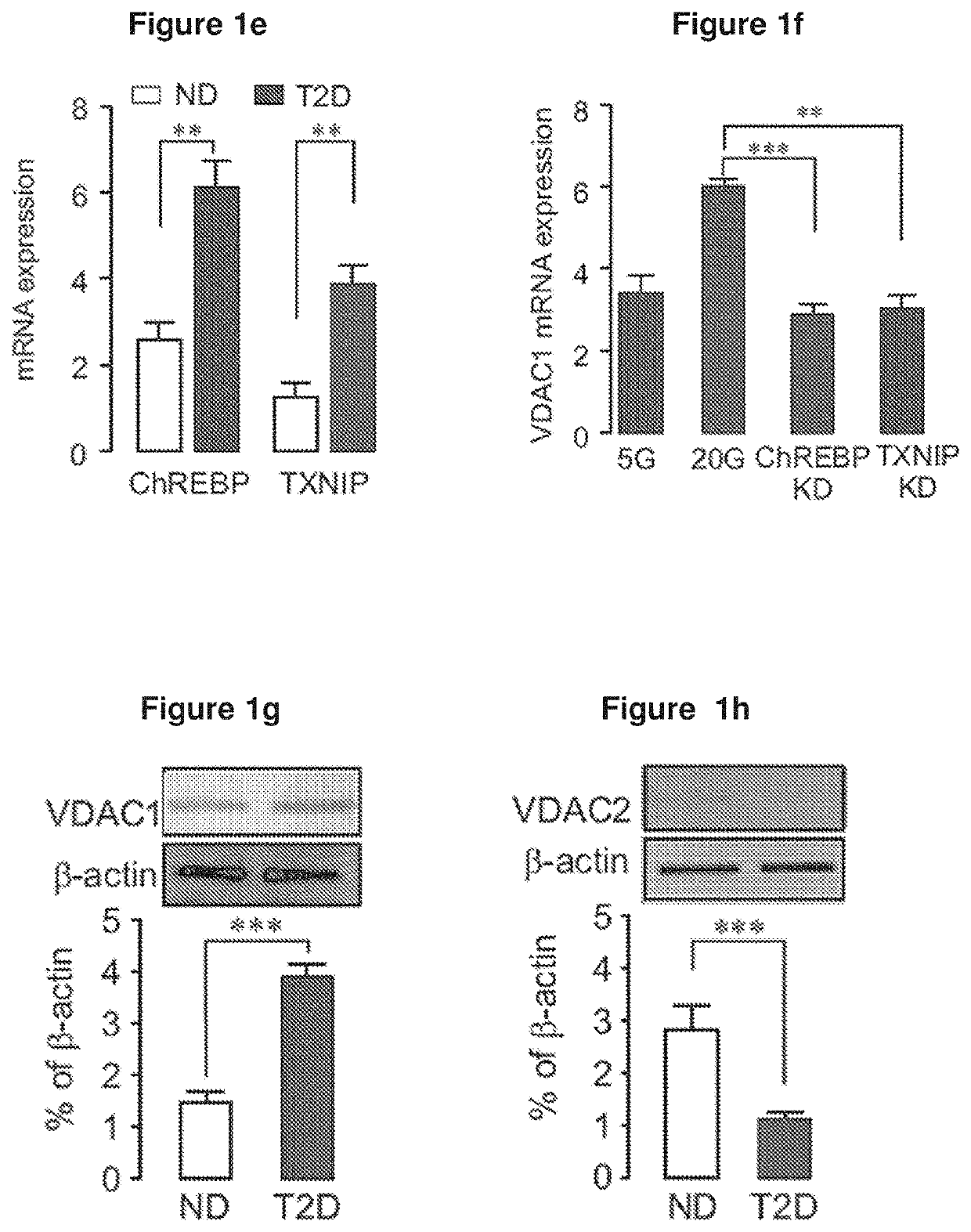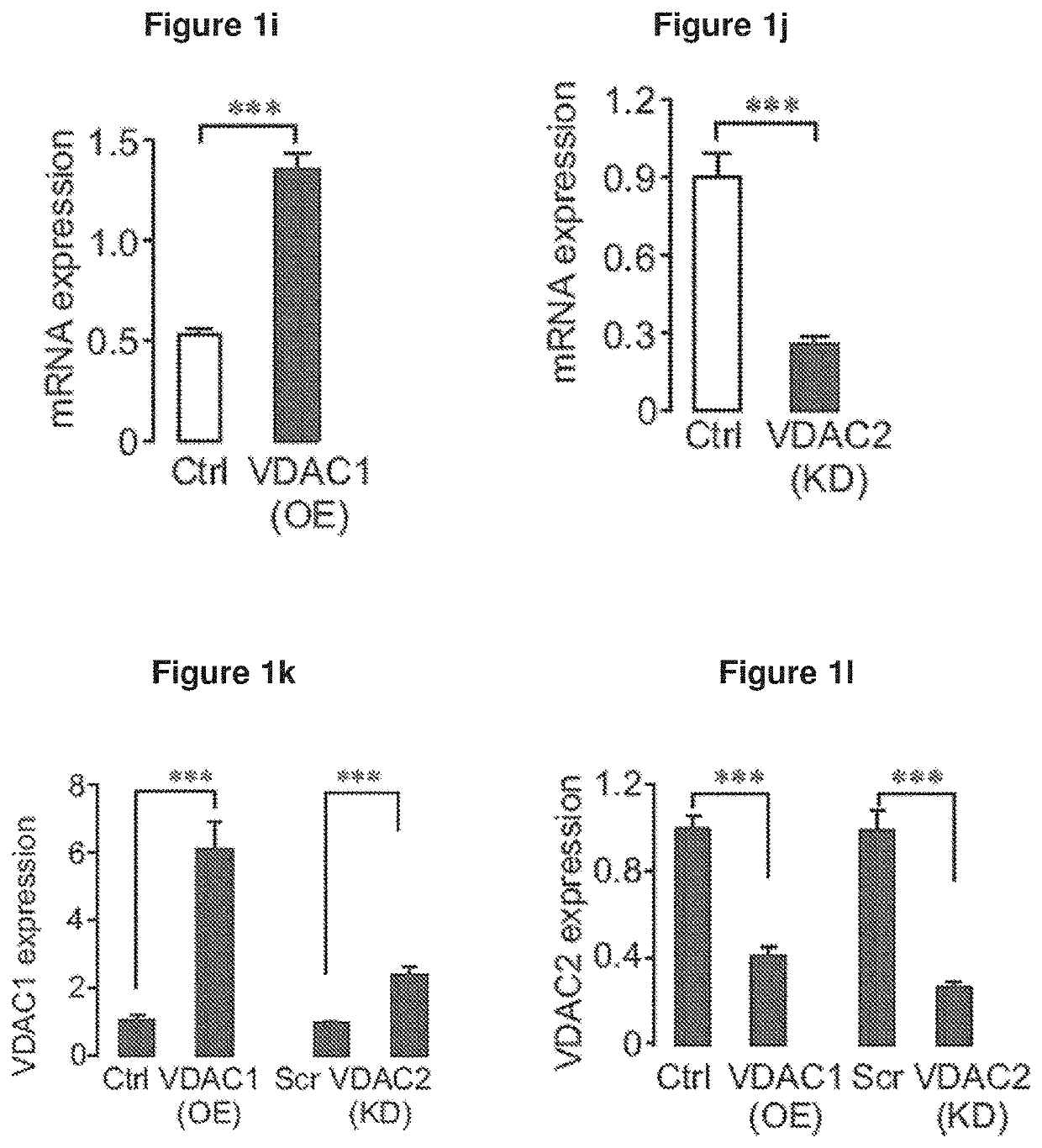Methods for treating diabetes using vdac1 inhibitors
a technology of vdac1 inhibitor and vdac1 agonist, which is applied in the field of vdac1 inhibitor and diabetes treatment, can solve the problems of insufficient insulin secretion to maintain normal blood glucose regulation, frequent episodes of hypoglycemia in patients with t1d, and long-term consequences on retinal and brain function, so as to prevent the progression of the disease, restore -cell function, and treat diabetes.
- Summary
- Abstract
- Description
- Claims
- Application Information
AI Technical Summary
Benefits of technology
Problems solved by technology
Method used
Image
Examples
example 1
ession and Function in β-Cells
[0306]FIGS. 1 and 2 depict the expression and function of VDAC in β-cells. In islets from T2D organ donors, VDAC1 mRNA was upregulated, while VDAC2 was repressed (FIG. 1a). Similar changes occurred at the protein level (FIGS. 1g and 1h). FIG. 1b shows that VDAC1 mRNA expression correlates with the preterminal blood glucose as reflected by HbA1c in ND (HbA1c2=0.27; P<0.049) (not shown). The insert shows islet VDAC1 mRNA in ND (n=15), in T2D including metformin treated donors (n=15) and T2D with documented metformin therapy (n=4). (*p<0.05, **P<0.001 by Anova). Islets from T2D donors with documented metformin therapy did not display elevated VDAC1 mRNA. In contrast, culture of human islets under glucotoxic conditions, reproduced the T2D profile, increasing VDAC1 and decreasing VDAC2 mRNA (FIG. 1c). FIG. 1d shows the expression of VDAC1 in non-diabetic human islets cultured for 72 h at 5 and 20 mM glucose in the presence or absence of metformin (Met, 20 μM...
example 2
ression and Localization in Human β-Cells
[0311]FIG. 3 illustrates the localization of VDAC1 in human β-Cells. FIG. 3a is immunofluorescence images of VDAC1 and VDAC2 in human islet β-cells cultured at 5 or 20 mM glucose (5G and 20G, respectively) for 72 h as well as in β-cells from T2D donors of which one had received metformin therapy. Note VDAC1 expressed prominently on the β-cell surface at 20G or in T2D islets. FIG. 3b shows β-cell surface expression of VDAC1 given as ratio of surface / cytosolic VDAC immunofluorescence intensity in islets of ND or T2D (n=8 donors each) as well as one T2D donor with documented metformin therapy. FIG. 3c shows that VDAC1-cell surface expression correlates with HbA1c values in islets of 15 T2D donors and non-diabetic islet donors. To verify the surface localization of VDAC1, double immunofluorescence staining was performed in pancreas sections of non-diabetic and T2D donors. VDAC1 was clearly overexpressed at the T2D beta cell surface, shown by the ...
example 3
t of VDAC1 Cell Surface Expression on ATP Handling, Insulin Secretion Membrane Conductance, and Cell Viability
[0312]To further substantiate the consequence of aberrant VDAC1 subcellular localization and overexpression, ATP levels during 1 h-experiments in plVDAC1-expressing INS-1 cells were monitored. Overexpression of wild type VDAC1 (mtVDAC1) resulted in a 3-fold increase in ATP release from the cells, suggesting mistargeting of VDAC1 to the plasma membrane. This was validated by plasma membrane targeted VDAC1 (plVDAC1) expression, which caused a 10-fold ATP loss (FIG. 4a). FIG. 4a shows ATP release after 1 h incubation at 1 (1G) or 16.7 mM glucose (16.7G) from INS-1 cells transfected with either mtVDAC1 or plVDAC1. For comparison, vector transfected controls are also shown. The robust GSIS in cells transfected with control plasmid was markedly reduced in mtVDAC1-transfected and completely abolished in plVDAC1-expressing cells (FIG. 4b). FIG. 4b shows glucose-stimulated insulin se...
PUM
| Property | Measurement | Unit |
|---|---|---|
| incubation time | aaaaa | aaaaa |
| incubation time | aaaaa | aaaaa |
| body weight | aaaaa | aaaaa |
Abstract
Description
Claims
Application Information
 Login to View More
Login to View More - R&D
- Intellectual Property
- Life Sciences
- Materials
- Tech Scout
- Unparalleled Data Quality
- Higher Quality Content
- 60% Fewer Hallucinations
Browse by: Latest US Patents, China's latest patents, Technical Efficacy Thesaurus, Application Domain, Technology Topic, Popular Technical Reports.
© 2025 PatSnap. All rights reserved.Legal|Privacy policy|Modern Slavery Act Transparency Statement|Sitemap|About US| Contact US: help@patsnap.com



